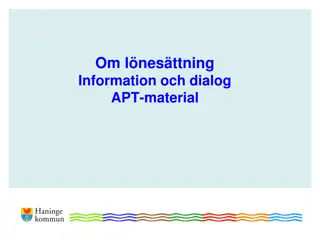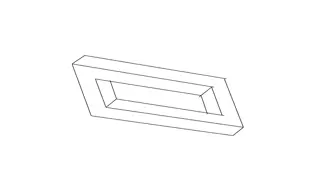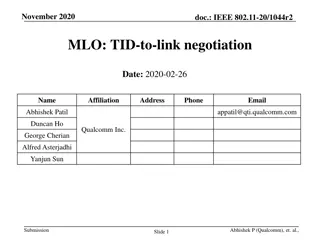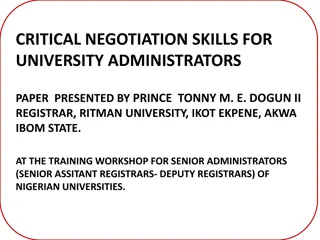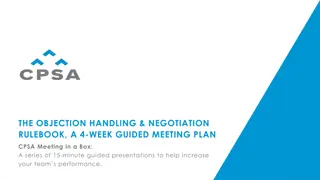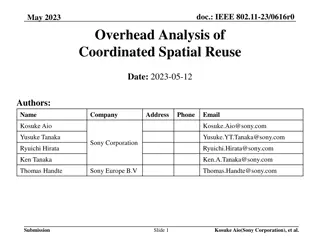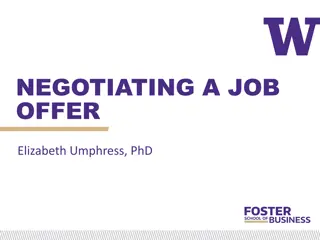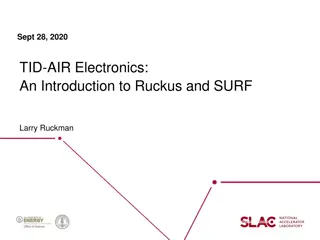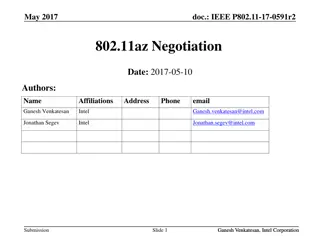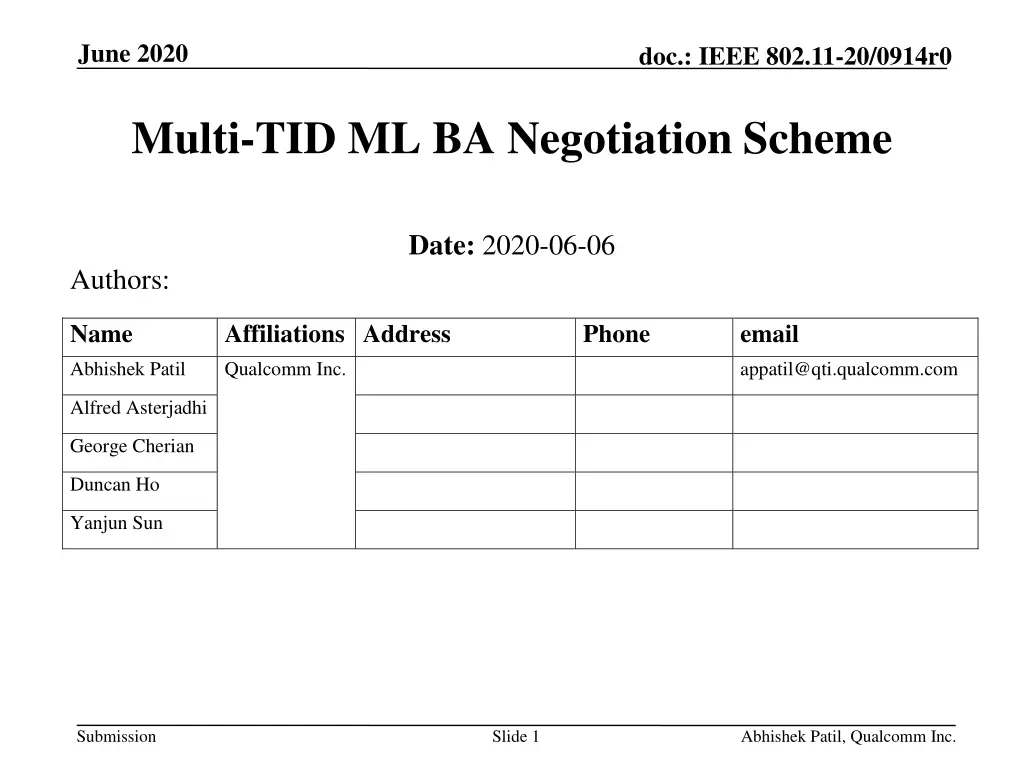
IEEE 802.11 Multi-TID BA Negotiation Scheme Overview
Explore the IEEE 802.11 multi-TID BA negotiation scheme proposed in June 2020 for enhanced throughput and reduced management signaling overhead. Learn about the background, considerations for EHT, and the proposed enhancements to the protocols.
Download Presentation

Please find below an Image/Link to download the presentation.
The content on the website is provided AS IS for your information and personal use only. It may not be sold, licensed, or shared on other websites without obtaining consent from the author. If you encounter any issues during the download, it is possible that the publisher has removed the file from their server.
You are allowed to download the files provided on this website for personal or commercial use, subject to the condition that they are used lawfully. All files are the property of their respective owners.
The content on the website is provided AS IS for your information and personal use only. It may not be sold, licensed, or shared on other websites without obtaining consent from the author.
E N D
Presentation Transcript
June 2020 doc.: IEEE 802.11-20/0914r0 Multi-TID ML BA Negotiation Scheme Date: 2020-06-06 Authors: Name Abhishek Patil Affiliations Address Qualcomm Inc. Phone email appatil@qti.qualcomm.com Alfred Asterjadhi George Cherian Duncan Ho Yanjun Sun Submission Slide 1 Abhishek Patil, Qualcomm Inc.
June 2020 doc.: IEEE 802.11-20/0914r0 Introduction Baseline block ack sessions are negotiated on a per-TID basis Start after successful exchanges of ADDBA Request/ADDBA Response TXer indicates parameter preferences, RXer has the final say on them EHT will increase the achievable throughput due to Increase of BW to 320 MHz, SSs to 16, QAM constellation to 4K, Introduction of multi-link operation, etc. Will lead to a richer parameter exchange during negotiation Expected buffer size increments to 1024 or even beyond that Expected mapping of TIDs (BA sessions) to different links, etc. Which will increase management level signaling for these purposes We propose to reduce such overhead while increasing flexibility of the negotiation process Submission Slide 2 Abhishek Patil, Qualcomm Inc.
June 2020 doc.: IEEE 802.11-20/0914r0 Background ADDBA Request Ack STA 1 Ack ADDBA Response STA 2 BA negotiation is performed with two action frames ADDBA Request and ADDBA Response exchanges (handshake) Each frame contains BA session parameters desired by the originator STA and the parameters agreed to (if accepted) by the recipient STA One handshake is required for each BA setup (tuple consisting of <RA, TA, TID>) There can be up to 16 BA sessions between two peer devices One per TID per direction E.g., <STA, AP, TID0-TID7> and <AP, STA, TID0-TID7> Each requires one set of ADDBA Request/ADDBA Response exchanges 4-frames per handshake (including ACK) More frame exchanges are needed if/when re-negotiations is needed Submission Slide 3 Abhishek Patil, Qualcomm Inc.
June 2020 doc.: IEEE 802.11-20/0914r0 Considerations for EHT In this contribution, we propose the following enhancements to the protocols 1. Enable BA setup during association phase 2. Enable multi-TID BA session negotiations 3. Enable TID to link mapping while negotiating BA sessions 4. Accelerate the negotiation process in case of disagreements Reducing the number of over-the-air management frames for (Re-)Negotiating block-ack sessions and TID-to-link mapping agreements Reducing the start time of BA sessions being in place Today BA sessions are negotiated immediately and independently after association Our proposal enables this to be done during association for multi TIDs and links with a single handshake Can help quickly resume data session in roaming scenarios Submission Slide 4 Abhishek Patil, Qualcomm Inc.
June 2020 doc.: IEEE 802.11-20/0914r0 Proposal Create a container (most likely an IE) for carrying the following information: One or more BlockAck Session Parameter Sets. Which consist of: BlockAck Action (to differentiate ADDBA Request/Response) Dialog Token Not necessary if element is carried in Action frames since Action frame can carry this field BlockAck Parameter Set (note that the TID is included here) Parameters related to BlockAck negotiation for each TID BlockAck Timeout, Starting Seq Number, ADDBA Extension, status code etc One or more TID-to-Link Mapping Parameter Sets To indicate the link(s) where a TID maps on to IE expected to carries sub-elements to provide a flexible structure The amount of information carried would depend on the number of BA session (TID/direction) and/or TID to link mapping being established or updated Expect a control field with fields to signal the operation and number of TIDs Optional subelements expected to carry BA parameter set and link information per TID per direction Submission Slide 5 Abhishek Patil, Qualcomm Inc.
June 2020 doc.: IEEE 802.11-20/0914r0 BA negotiation during association phase Include ADDBA Parameter Set element to Association Request frame With list of TIDs for which a BA setup request is being sent Plus their BA parameters and TID-to-link mapping The Assoc Req frame can also include default BA parameter set and TID mapping for the reverse direction Equivalent to a non-AP MLD s preferred set if it were to respond to an ADDBA Request from the AP MLD helps quickly converge to a mutually agreeable set and reduces further exchange of frames. Include ADDBA Parameter Set element to Association Response Same as above Submission Slide 6 Abhishek Patil, Qualcomm Inc.
June 2020 doc.: IEEE 802.11-20/0914r0 BA negotiation after association phase Extend existing ADDBA frames to carry the new IE To signal BA setup for more than one TID Provide TID mapping for more than one TID Existing ADDBA framework can still be used for establishing or re-negotiating BA setup for a single TID Benefit, single ADDBA exchange (4 frames) can establish or update the BA setup or TID mapping (or both) for more than one TID Content similar to that exchanged during Assoc Req/Resp. Submission Slide 7 Abhishek Patil, Qualcomm Inc.
June 2020 doc.: IEEE 802.11-20/0914r0 Additional considerations Signaling to indicate support for TID-mapping default mapping if either MLD doesn t supporting TID mapping 1 bit in EHT Cap Signaling to indicate acceptance of default parameter Eliminates an explicit frame confirming the ADDBA Request for the reverse direction 1 bit in ADDBA Response sent for the forward direction Reason code(s) to indicate failure of the setup for a TID or disinterest to participate in setup ML setup can be successful while BA setup or TID mapping for one or more TID was a failure Rejection may be since the other MLD is not interested or ready for proactive setup for a particular TID. Submission Slide 8 Abhishek Patil, Qualcomm Inc.
June 2020 doc.: IEEE 802.11-20/0914r0 Summary In this contribution, we propose a mechanism to extend the existing BA setup mechanism to more than one TID. Include TID to link mapping as part of the BA setup Further extend the mechanism to reverse direction Propose to allow BA setup performed during (re)association (ML setup). Cuts down the delay in getting to the data session can help roaming scenarios Submission Slide 9 Abhishek Patil, Qualcomm Inc.
June 2020 doc.: IEEE 802.11-20/0914r0 SP #1 Do you agree to have a bit in EHT Capabilities element to indicate if the transmitting MLD supports TID-to- link mapping or not? NOTE: the MLDs use default mapping if either MLD doesn t supporting TID mapping Y: N: A: Submission Slide 10 Abhishek Patil, Qualcomm Inc.
June 2020 doc.: IEEE 802.11-20/0914r0 SP #2 Do you support that ADDBA Request / ADDBA Response frames extended to perform TID-to-link mapping negotiation? Y: N: A: Submission Slide 11 Abhishek Patil, Qualcomm Inc.
June 2020 doc.: IEEE 802.11-20/0914r0 SP #3 Do you support to extend the existing ADDBA frame exchange to perform one or more of: BA negotiation for more than one TID TID-to-link negotiation for more than one TID NOTE: Exact signaling (e.g., defining an IE structure to carry information of other TIDs) is TBD Y: N: A: Submission Slide 12 Abhishek Patil, Qualcomm Inc.
June 2020 doc.: IEEE 802.11-20/0914r0 SP #4 Do you support to add a mechanism in Association Request / Association Response frame exchange to perform BA setup negotiation for one or more TIDs? Y: N: A: Submission Slide 13 Abhishek Patil, Qualcomm Inc.
June 2020 doc.: IEEE 802.11-20/0914r0 SP #5 Do you support to add a mechanism in Association Request / Association Response frame exchange to perform TID-to-link mapping negotiation for one or more TIDs? Y: N: A: Submission Slide 14 Abhishek Patil, Qualcomm Inc.
June 2020 doc.: IEEE 802.11-20/0914r0 SP #6 Do you support to add a mechanism by which an MLD can proactively indicate for each TID the following? its default BA parameter set for the reverse direction its default link-mapping for the reverse direction Y: N: A: Submission Slide 15 Abhishek Patil, Qualcomm Inc.
June 2020 doc.: IEEE 802.11-20/0914r0 SP #7 Do you support to add a signaling mechanism by which an MLD can indicate for each TID for each setup (BA or TID-mapping) the following? Acceptance of default parameters advertised by initiating MLD in it a preceding Request frame Unwillingness to participate in a setup proactive initiated by a peer MLD Y: N: A: Submission Slide 16 Abhishek Patil, Qualcomm Inc.
June 2020 doc.: IEEE 802.11-20/0914r0 APPENDIX Submission Slide 17 Abhishek Patil, Qualcomm Inc.
June 2020 doc.: IEEE 802.11-20/0914r0 Contents of ADDBA Req/Resp frames Submission Slide 18 Abhishek Patil, Qualcomm Inc.

